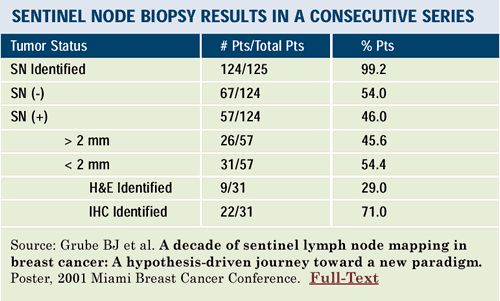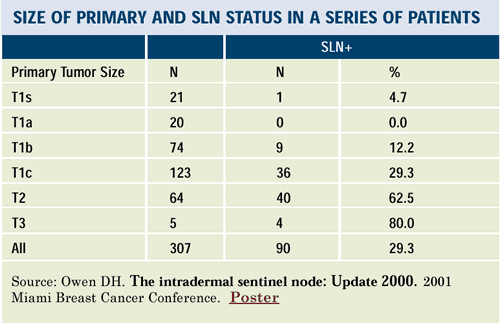|

What are the current indications for sentinel
node biopsy, and how should enhanced pathology (such as IHC) be
used in clinical decision-making?
 |
|
OVERVIEW:
A series of classic randomized trials — including
NSABP B-04 — formed the basis for level 1 and 2
axillary node dissection becoming a standard of care
for invasive breast cancer. The emergence of sentinel
node biopsy (SNB) as an initial staging procedure has
led to a new generation of trials evaluating the need
for axillary dissection in women with both pathologically
negative and positive SNB. In the United States, NSABP
B-32 is evaluating the management of patients with negative
sentinel node biopsies by randomization to either axillary
node dissection or no further axillary surgery. While
many investigators are convinced that the anatomic hypothesis
of the sentinel node has been demonstrated, one important
outcome of the NSABP trial will be to observe the accuracy
and reproducibility of this procedure with many surgeons
in various clinical settings. Another key U.S. sentinel
node trial is being conducted by the American College
of Surgeons. This groundbreaking study will evaluate
whether axillary node dissection is necessary in sentinel
node-positive patients treated with lumpectomy and breast
irradiation. A key factor is whether the additional
antitumor effect of adjuvant systemic therapy mitigates
the need for axillary dissection in these women. In
addition, another critical question addressed by trials
of the American College of Surgeons is the interpretation
of micrometastases in both the sentinel lymph node and
the bone marrow. The clinical significance of these
findings on enhanced pathology is a critical treatment
issue, which becomes even more important as the use
of sentinel node biopsy increases.
|
|
 |
 |
| |
| |
Mean
|
|
Approximately how many sentinel node
biopsies have you performed in the last year?
|
15.5
|
|
Approximately what fraction was positive?
|
33%
|
|
Approximately how many axillary dissections
have you performed in the last year (without sentinel
node biopsy)?
|
20.7
|
|
| What technique do
you generally utilize for sentinel node biopsy? |
DYE
|
RADIOISOTOPE
|
BOTH
|
|
8%
|
8%
|
84%
|
Is sentinel node biopsy generally a good
option for the following women:
|
YES
|
| A 56-year-old woman with a 2 cm breast cancer
in the upper outer quadrant and a 1 cm breast cancer in
the lower inner quadrant |
46%
|
A 42-year-old woman with a 3 cm breast cancer
who wants mastectomy with immediate reconstruction
using TRAM flap
|
60%
|
A 55-year-old woman with a 2 cm breast cancer
high in the upper outer quadrant in the tail of Spence
|
78%
|
 |
Is sentinel lymph
node biopsy a standard of care for patients with clinical
T1NO cancer?
|
70%
|
Do you ever do axillary
node dissection on an outpatient basis?
|
69%
|
|
 |
 |
| |
 |
| NSABP B-04 TRIAL: A PROTOCOL FOR THE EVALUATION
OF RADICAL MASTECTOMY VERSUS TOTAL MASTECTOMY WITH AND
WITHOUT RADIATION IN THE PRIMARY TREATMENT OF BREAST CANCER
CLOSED PROTOCOL |
|
|
|
| Fisher B et al. Ten-year results of a randomized clinical
trial comparing radical mastectomy and total mastectomy with
or without radiation. N Eng J Med 1985; 312:674-681. Abstract |
|
“Our findings indicate that the location of a breast
tumor does not influence the prognosis and that irradiation
of internal mammary nodes in patients with inner-quadrant
lesions does not improve survival. ... We conclude that the
variations of local and regional treatment used in this study
are not important in determining survival of patients with
breast cancer.”
|
 |
 |
| AMERICAN COLLEGE OF SURGEONS Z-10 TRIAL:
A PHASE III PROGNOSTIC STUDY OF SENTINEL NODE AND BONE
MARROW MICROMETASTASES IN WOMEN WITH STAGE I OR IIA BREAST
CANCER PROTOCOL |
|
|
|
|
All patients receive whole breast radiotherapy (exclusive
of a supraclavicular field) 5 days a week for a maximum of
7 weeks and systemic adjuvant therapy.
Patients with no sentinel node identified intraoperatively
and patients with sentinel node metastasis identified by H
& E who choose not to be registered to ACOSOG-Z0011 undergo
ALND.
|
 |
|
STUDY CONTACT
Armando E Giuliano, Ph: 310-829-8089
John Wayne Cancer Institute
Santa Monica, California
|
 |
| NSABP B-32 TRIAL: PHASE III RANDOMIZED
STUDY OF SENTINEL NODE DISSECTION WITH OR WITHOUT CONVENTIONAL
AXILLARY DISSECTION IN WOMEN WITH CLINICALLY NODE-NEGATIVE
BREAST CANCER OPEN
PROTOCOL |
|
|
|
|
All patients receive technetium Tc 99m sulfur colloid injected
into normal breast tissue within 1 cm of the primary tumor
or biopsy cavity, approximately 0.5-8 hours before surgery.
Patients also receive an injection of isosulfan blue dye
around the tumor or biopsy cavity after a hot spot is identified
with a gamma detector.
|
 |
|
STUDY CONTACT:
David N. Krag, Chair, Ph: 802-656-5830
National Surgical Adjuvant Breast and Bowel Project
Pittsburgh, Pennsylvania
|
 |
| AMERICAN COLLEGE OF SURGEONS Z-11 TRIAL:
A PHASE III RANDOMIZED STUDY OF AXILLARY LYMPH NODE DISSECTION
IN WOMEN WITH STAGE I OR IIA BREAST CANCER WHO HAVE A
POSITIVE SENTINEL NODE OPEN
PROTOCOL |
|
|
|
| Patients in both arms may receive adjuvant systemic
therapy at the discretion of the treating physician. |
 |
|
STUDY CONTACT
Armando E Giuliano, Ph: 310-829-8089
John Wayne Cancer Institute
Santa Monica, California
|
| |
AXILLARY DISSECTION FOR SNB-POSITIVE PATIENTS
For 20 years, we have been hearing that axillary surgery is a
staging procedure. However, once you have a positive node, the patient
is staged, so does it make sense to subject her to the morbidity
of an axillary dissection? I think the answer to that right now
is, yes, for several reasons.
First, axillary dissection will maintain local control in the
axilla in 98-99 percent of patients — whether they’re
node-positive or node-negative. That’s very important because
uncontrolled axillary disease is extremely difficult to treat and
extremely morbid. Also, medical oncologists need to accurately estimate
the risk of recurrence to educate patients about the risks and benefits
of adjuvant therapy. To do that, in general, you need to know the
number of positive nodes.
The therapeutic benefit of axillary dissection remains open. NSABP
B-04 showed no survival benefit, but the trial was a premammography
era study, so the patients had larger tumors, and no adjuvant therapy
was being used at that time. Also, the sample size was not large
enough to detect a small survival difference that today we would
think is clinically relevant.
Currently, the standard management of a positive sentinel node
is to complete the axillary dissection, although there are individual
circumstances where that might not be appropriate. I’m proud
to say that our center has the second-highest accrual to the American
College of Surgeons trials — basically asking the same question
as NSABP B-04 in a modern setting. Without these trials, we will
still be asking this question 10 years from now and making random
decisions.
—Monica Morrow, MD
ACCRUAL TO SENTINEL NODE TRIALS
In some ways sentinel node mapping is becoming a victim of its
own success. As surgeons realize that it is not a terrific technical
feat to learn, and as more patients become aware of it through the
Internet and other sources, it will become harder and harder to
find both patients and physicians willing to participate in these
randomized clinical trials.
—Patrick Borgen, MD
CONTRIBUTION OF SURGEONS TO BREAST CANCER RESEARCH
Although other physicians are increasingly involved in the primary
management of cancer, surgeons remain largely responsible for determining
such care and deciding whether patients enter clinical trials. Surgeons
have not only inaugurated the use of systemic adjuvant therapy and
continue to be leaders in that effort, they have also redefined
the basis for oncologic surgical operation and, in so doing, have
contributed to a better understanding of the biology of cancer and,
consequently, its treatment.
—Bernard Fisher, MD, News
from the Commission on
Cancer of the American College of Surgeons 1991;2(2)
COMMENTS FROM SURGICAL RESEARCH LEADERS ON SENTINEL
NODE TRIALS
There are three reasons to do axillary dissection: regional control,
staging and to improve survival. For staging, we have enough literature
from around the world to tell us the accuracy of sentinel node biopsy.
For regional control, surgery results in almost 100% control, as
does radiation therapy, so before we abandon something that works
very well, we have to be very careful. We don't have any long-term
data on regional control for sentinel node. Regarding the issue
of survival — and I know it is a little heretical to say this
— there may be a survival advantage in controlling the axilla.
The few studies that looked at this were done in an era when we
randomized hundreds of patients, not thousands of patients. So the
statistical power was not there.
I've personally never done a sentinel node procedure in a breast
cancer case outside of a clinical trial. I'm not going to say that
it shouldn't be done — this is a judgment call. But in terms
of making the claim that sentinel node is as good as axillary dissection,
we don't have the data and we are in an era of evidence-based medicine.
—David Krag, MD
Many surgeons believe that axillary dissection is therapeutic,
and they are reluctant not to perform axillary dissection in sentinel
node-positive patients. However, a number of randomized studies
failed to show that axillary dissection improves survival. In sentinel
node-positive women, the sentinel node may be enough because often
it's the only involved node.
Virtually all node-positive women in this country receive adjuvant
systemic therapy, which may take care of any residual problem in
the axilla. Many patients are also receiving opposed tangential
field radiation, and that's partial axillary radiation.
In studies where patients received lumpectomy with radiation and
no axillary dissection, the axillary recurrence rate was extraordinarily
low. I think ACOS Z-11 is a very important, very justifiable and
ethical trial. For an operation that's been used for 100 years,
it's time to answer the question about the need for axillary dissection.
—Armando Giuliano, MD


View References
Back | Top of Page

|
|



